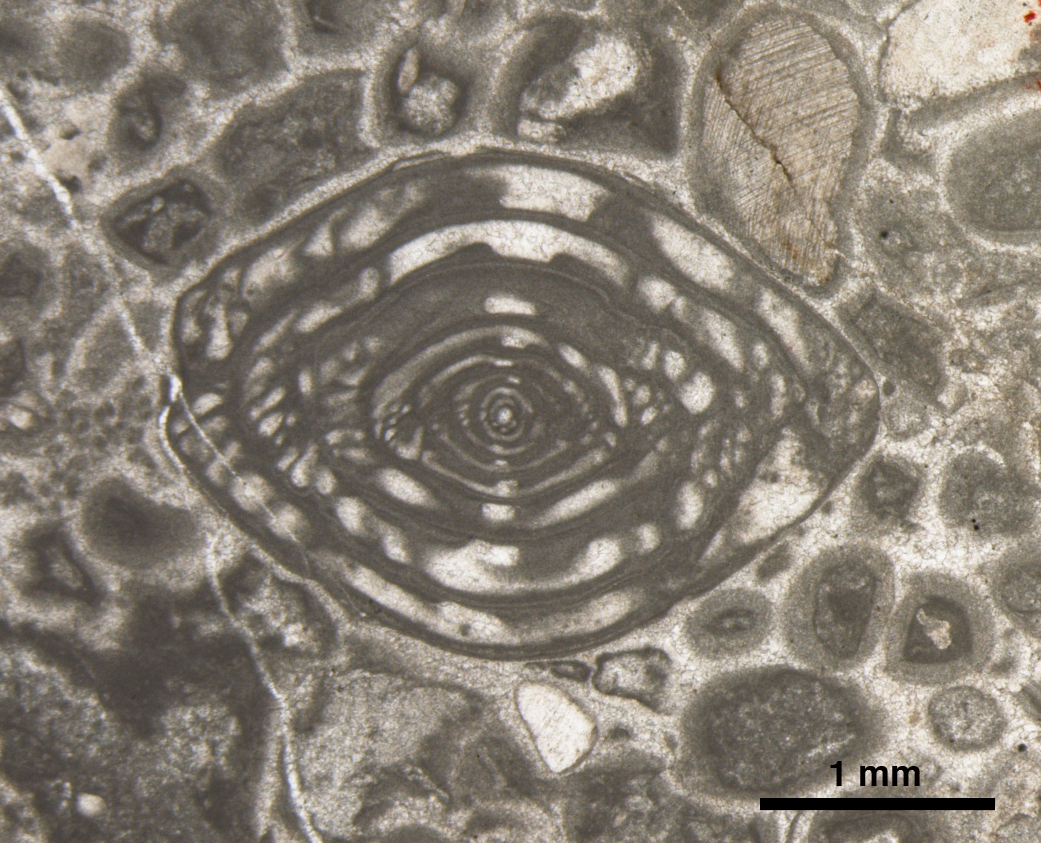Bulletin of the Geological Survey of Japan Top Page
Bulletin of the Geological Survey of Japan Vol.66 No.11/12 (2015)
Cover photograph | Table of Contents | Abstract
Cover photograph
A Pennsylvanian fusuline species, Fusulinella biconica (Hayasaka) from the Omi Limestone, Niigata Prefecture, central Japan
The Omi Limestone is an atoll-type limestone
body embedded in the Permian Akiyoshi
accretionary complex. Atoll-type limestones are generally of high quality for industrial use because of high purity of calcium carbonate, but some of them exhibit high phosphorus content unsuitable for use in steel and carbide plants. Chemical analysis of limestone of each depositional age and environment reveals the detailed maldistribution of phosphorus in a limestone body. Fusuline foraminifers are examined to assess the age of the Carboniferous‒Permian limestones.
(Photograph and Caption by Tsutomu Nakazawa)
Table of Contents
All the pages PDF : 66_11_full.pdf [3.1MB]
| Title | Author | |
|---|---|---|
| Article | ||
| Maldistribution of phosphorus in the Carboniferous–Permian atoll-type limestones of the Akiyoshi accretionary complex |
Kentaro Sakata, Tsutomu Nakazawa, Takashi Okai and Katsumi Ueno(p199-212) | 66_11_01.pdf [2.3MB] |
Abstract
Maldistribution of phosphorus in the Carboniferous–Permian atoll-type limestones of the Akiyoshi accretionary complex
Kentaro Sakata, Tsutomu Nakazawa, Takashi Okai and Katsumi Ueno
Although atoll-type limestones in accretionary complexes are characterized by having high purity of calcium carbonate, some of them exhibit high phosphorus content comparatively. Such limestones are unsuitable for use in steel and carbide plants. It is important for mine development to understand the maldistribution of phosphorus in limestones. We measured phosphorus content of Carboniferous–Permian atoll-type limestones embedded in the Akiyoshi accretionary complex by using ICP-AES. Those samples were classified by age and depositional environment. We recognized that in samples from the reef-core environment phosphorus contents generally exhibit higher value in the Bashkirian and Moscovian than in the Visean, Serpukhovian, and Gzhelian. In contrast, back-reef limestones are characterized by the low content of phosphorus even in the Bashkirian and Moscovian. Phosphorus content is uncorrelated with those of iron and aluminum that are generally considered as the secondary accumulation. The high content of phosphorus in the Bashkirian and Moscovian reef-core limestones suggests the high nutrient level in seawater during the deposition of the limestones. It is probably related with rising sea-level caused by coeval super-plume activity in the Panthalassa ocean and resultant dominant upwellings.
Geological Survey of Japan, AIST
- About GSJ
- Our Activities
- Purchase guide
-
Publications and Database
- information
- Bulletin of the Geological Survey of Japan
- bull2025(Vol.76)
- bull2024(Vol.75)
- bull2023(Vol.74)
- bull2022(Vol.73)
- bull2021(Vol.72)
- bull2020(Vol.71)
- bull2019(Vol.70)
- bull2018(Vol.69)
- bull2017(Vol.68)
- bull2016(Vol.67)
- bull2015(Vol.66)
- bull2014(Vol.65)
- bull2013(Vol.64)
- bull2012(Vol.63)
- bull2011(Vol.62)
- bull2010(Vol.61)
- bull2009(Vol.60)
- bull2008(Vol.59)
- bull2007(Vol.58)
- bull2006(Vol.57)
- bull2005(Vol.56)
- bull2004(Vol.55)
- bull2003(Vol.54)
- bull2002(Vol.53)
- bull2001(Vol.52)
- Bulletin of the Geological Survey of Japan(old)
- Annual Report on Active Fault and Paleoearthquake Researches
- Reports, Geological Survey of Japan
- CCOP-GSJ Groundwater Project Report
- CCOP Technical Bulletin
- Cruise Report
- Geological Hazards
- Learning and Education
- GSJ Database Collection
- Collection of links


